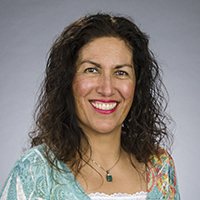14 April 2016
The Promise of Precision Medicine: Are We There Yet?

The genome is the entire set of genetic instructions found in a cell and offers a complete mapping of all of genes in human beings. (Darryl Leja, NHGRI graphic)
The rise of the study of the genome is behind what’s been referred to as the genomic revolution –scientific innovation meant to pave way for individualized medical treatment plans.
It’s also something that has stirred-up patient questions of whether or not health care is truly there yet.
Following billions of dollars and more than two decades of work, the Human Genome Project brought together researchers from around the world to complete mapping and understanding of all the genes of human beings, together known as our “genome.”
The result is a shifting of science away from population-based “average patient” care approaches towards the discovery of every individual and their specific predisposition of disease.
This has created public hype that forecasts a future filled with doctors who are better equipped to understand the entire health story of each patient. Media helped give way to such hope during coverage of the 2015 State of the Union Address that revealed plans for tailored heath care that’s free of “one-size-fits-all” approaches, now formally called the Precision Medicine Initiative.
 Larry Mimms, Ph.D.
Larry Mimms, Ph.D.
The goal is early detection and intervention and one day personalized medicine for all, says Larry Mimms, Ph.D., chief scientific officer of Prometheus Labs located in San Diego, where he is also an instructor for UC San Diego Extension.
However, the reality is, we’re not quite there yet for common diseases such as diabetes and cancer, something that will soon be identified through global in vitro diagnostic (IVD) tests, according to a report by Grand View Research.
As the number of adults living with diabetes has quadrupled since 1980, according to the World Health Organization, it’s obvious that revolutionary prevention and treatment approaches are long overdue for such disease.
What’s going to take us there are innovations in drug development, clinical diagnostics, such as IVD, and genomic technologies that incorporate traditional epidemiology research, according to the National Human Genome Research Institute.
Currently, laboratory testing influences more than 70 percent of all medical decisions, but compromise hospital cost without enhanced testing precision methods. In order to change the paradigm in the future, better disease markers, genotyping and customization of therapy is needed, says Mimms.
“IVD will be a major beneficiary of the true genomic revolution, as well as noninvasive prenatal testing, classification of cancers and microbiomics, the study of diversity in the gut,” he said.
Specifically, biomarker development and research will expand the scope of relevant clinical endpoints, the variables that represent a patient’s health and well-being from their perspective – how they feel, function and survive.
A biomarker is defined by the National Institute of Health (NIH) as a characteristic that is objectively measured and evaluated as an indicator of normal biological processes, pathogenic processes or pharmacological responses to therapeutic intervention. That includes everything from pulse and blood pressure through basic chemistries to more complex laboratory tests of blood and other tissues.
These complex best approaches within clinical research, including laboratory-measured biomarkers, are still being developed and refined according to NIH.
 Jelveh Lameh, Ph.D.
Jelveh Lameh, Ph.D.
“Biomarkers will be a source of information throughout each phase of testing and drug development. The FDA has started to take initiatives to integrate personalized medicine into regulatory policies, as well as genetic and biomarker information for clinical use and drug development,” said Jelveh Lameh, Ph.D., director of BioPharma Services at Genoptix of Carlsbad, and Biomarker instructor with Extension.
Lameh and her team are part of efforts that support clinical trials for oncology and work in part to develop testing that will uncover various types of cancer characteristics so they may be classified in order to find the best treatment possible for each particular type of cancer.
Although the genomic revolution may not be part of a nationwide experience, major cancer centers, such as the Mayo Clinic, are able to provide such treatment. It’s here that patients can have their tumors sequenced, with the goal of finding a matched drug that will precisely target the mutation that drives growth, as reported by Ron Winslow for the Wall Street Journal.
Such examples bring additional hope that the evolution of health care isn’t too far out of reach.
In an effort to help train the future scientists of the genetic revolution, Extension has created an innovative life sciences portfolio that includes intensive workshops designed to address emerging trends and industry challenges. Upcoming spring workshops include In Vitro Diagnostics Product Development from Friday-Saturday, April 29-30 and Biomarkers from Monday-Wednesday, May 9-11.
For more information or to register, visit extension.ucsd.edu/sciences. To stay connected, follow UC San Diego Extension science programs @UCSDExtSciences.